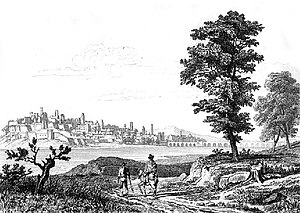
Back معركة خبورا Arabic Schlacht am Gévora German Batalla de Gévora Spanish Bataille de Gebora French Pertempuran Gebora ID Battaglia del Gebora Italian Bitwa nad Geborą Polish Batalha de Gévora Portuguese Битва при Геборе Russian Slaget vid Gebora Swedish
| Battle of the Gebora | |||||||
|---|---|---|---|---|---|---|---|
| Part of the Peninsular War | |||||||
 View of Badajoz, across the Guadiana river from the foothills of the San Cristóbal heights, by Eugène-Ferdinand Buttura | |||||||
| |||||||
| Belligerents | |||||||
|
| |||||||
| Commanders and leaders | |||||||
| Strength | |||||||
| 7,000[1] | 12,000[1] | ||||||
| Casualties and losses | |||||||
| 400 killed, wounded or captured |
1,000 killed or wounded 4,000 captured | ||||||
Castile 1811–13

125miles
The Battle of the Gebora took place during the Peninsular War between Spanish and French armies on 19 February 1811, northwest of Badajoz, Spain. An outnumbered French force routed and nearly destroyed the Spanish Army of Extremadura.
In a bid to help extricate Marshal André Masséna's army from its position in Portugal—mired in front of Lisbon's defensive Lines of Torres Vedras—Marshal Jean de Dieu Soult led part of the French Armée du Midi (Army of the South) from Andalusia into the neighbouring Spanish region of Extremadura and laid siege to the important fortress town of Badajoz. Viscount Wellington and the Spanish captain-general Pedro Caro y Sureda, 3rd marqués de La Romana, sent a large Spanish army to raise the siege. La Romana, however, died before the army could depart, and command fell to General Gabriel de Mendizábal Iraeta. Supported by a small force of Portuguese cavalry, the Spaniards reached the town and camped on the nearby heights of San Cristóbal in early February 1811.
When Mendizábal ignored Wellington's instructions and failed to entrench his army, Soult took advantage of the vulnerable Spanish position and sent a small force to attack the Spaniards. On the morning of 19 February, French forces under Marshal Édouard Mortier quickly defeated the Spanish army, inflicting 1,000 casualties and taking 4,000 prisoners while losing only 400 men. The victory allowed Soult to concentrate on his assault of Badajoz, which fell to the French on 11 March and remained in French hands until the following year.
- ^ a b Gates 1986, p. 248.